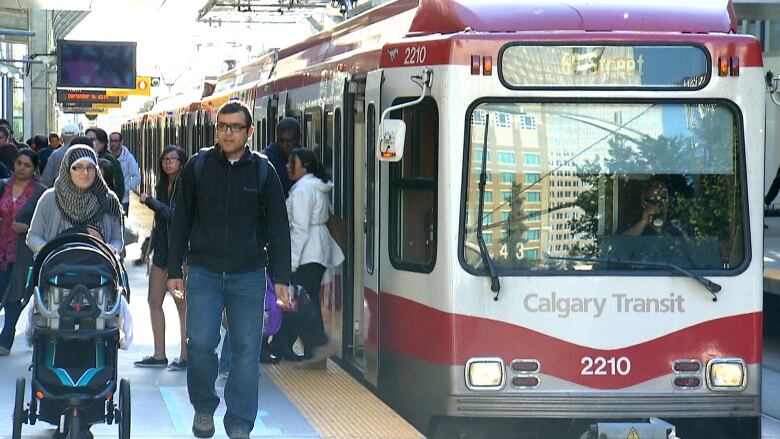Rapid-transit expansion led by Calgary, Vancouver, says Pembina
Calgary, Vancouver rail systems more cost effective than subways in Toronto, Montreal

Calgary and Vancouver have led big Canadian cities in the building of new rapid transit for the last decade, while Toronto and Montreal trail badly, according to a Pembina Institute report.
"Fast Cities: A comparison of rapid transit in major Canadian cities" compares rapid transit expansion in Canada's five largest cities, with Ottawa also included in that mix.
It says the choice of technology is the most significant factor in the disparity among the cities.
- North LRT line should run up Centre Street, Calgary transit says
- Tuscany LRT station opens in northwest Calgary
While Toronto and Montreal had a major head-start in terms of construction, the report says, they chose to build subways, while theother major cities chose more affordable and quicker-to-deploy technologies such as light rail transit and bus rapid transit.

As a result, the report says, cities such as Calgary and Vancouver were able to build more infrastructure more rapidly and at a lower cost.
According to the report, Toronto has the least cost-effective transit investment plan in the country.
By focusing on below-ground rail, the reportsays, it will spend an average of $236 million per kilometre of new rapid transit far more than the other cities.
Toronto, Montreal being surpassed
Toronto and Montreal created strong transit cultures by investing in subways a generation ago," institute spokeswoman Cherise Burda says in the release accompanying the report. "However, theyre now being surpassed by cities like Vancouver and Calgary, which have adopted more flexible transit solutions to serve their growing populations.
The institute used six criteria in defining rapid transit:
- Separated from traffic: Vehicles that either travel on a grade-separated path, or in their own lane or track that interacts with other traffic only at intersections or crossings. This makes them immune to traffic congestion.
- Priority signalling: For LRT, BRT, rapid streetcars and some express buses, vehicles that are not grade-separated receive priority from traffic signals.
- All-day, two-day service: Routes that provide regular service throughout the day, including within the city core. This differentiates them from regional commuter routes with peak-only service, or commuter service that skips over stops within the city itself.
- Maximum wait of 10 minutes during peak times: Rush-hour commuters should not be waiting longer than 10 minutes, and ideally not more than five minutes, for a transit vehicle.
- Maximum wait of 15 minutes during off-peak times: Fifteen minutes has been identified as frequent enough service that riders dont have to plan their trip around a timetable.
- Optimal spacing of stops and stations: Stops are spaced close enough for riders to walk to them, but far enough apart to keep vehicles moving. Vehicles stop less frequently than regular bus or streetcar service.
- Network connectivity: A rapid transit line needs to connect to a larger network, rather than terminate at, or merge into, non-rapid modes of transportation.
- Off-board fare collection and platform-level boarding: The vehicle operator does not collect fares and passengers can step directly from a platform into the vehicle without using stairs. Both of these measures expedite boarding.
Report offers snapshot
The distinction between rapid, express and other forms of transit is not always clear, and has become increasingly blurred in recent years as new technologies and hybrid systems have proliferated.
The report offers snapshot of Canada's rapid transit expansion:
- Calgary and Vancouver have built the most rapid transit over the last 10 years. During that time, the two cities have opened 20 and 22 kilometres of new lines, respectively.
- Calgary leads Canadian cities in terms of most rapid transit infrastructure per capita with its LRT network, followed closely by Ottawa.
- Torontonians take the most trips on rapid transit, an average of 133 per year. Despite this, Toronto has less infrastructure per capita to accommodate riders than Calgary, Ottawa or Montreal.
- Montreal leadsin easy access: 37 per cent of its population lives within walking distance of rapid transit.
- In terms of overall transit growth, Vancouver leads the way due to its considerable investment in its Skytrain lines.
The report notes all of Canada's major cities are moving to expand rapid transit:
- A subway extension and several new LRT lines are either funded or already under construction in Toronto.
- A new LRT line is under construction in Ottawa.
- Vancouver is building a new SkyTrain line.
- The construction of a new bus rapid transit (BRT) line in Montreal is expected to begin shortly.
- Calgary opened its most recent LRT extension in August 2014, completing a 17-station expansion program that began in 2001. There are plans to add new LRT lines and stations in the future, but none of them are funded at this time. The city has secured partial funding for the green line, a major BRT line that would operate on a transitway, and which would later be converted into light rail.
Important investment, says Calgary mayor
Calgary Mayor Mayor Naheed Nenshi said rapid transit is an important investment for a growing city.
"It's an investment in air quality," he said.
"It's an investment in bringing back people's quality of life, so they can actually get home and spend time with their families and not be in choked highways.
"And finally, it's an investment in social mobility in allowing people to participate fully in their communities, even if they can't afford to have a car."
Nenshi said that while the city is looking at up to $14 billion in rapid-transit investment over the next 30 years, the federal government should have a national transit strategy to help cover the costs.
The Pembina Institute is a non-profit organization that seeks to advance clean energy solutions through research, education, consulting and advocacy, its website says.












_(720p).jpg)


 OFFICIAL HD MUSIC VIDEO.jpg)
.jpg)



























































































